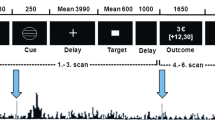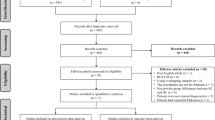Abstract
Rational
Clinical studies in patients with schizophrenia suggest that atypical neuroleptics are more effective than typical neuroleptics in reducing negative symptoms including apathy and anhedonia. Dysfunction of the dopaminergic reward system may contribute to negative symptoms in schizophrenia.
Objective
We used functional magnetic resonance imaging to assess the blood oxygen level dependency response in the ventral striatum of medicated schizophrenics and healthy control subjects during reward anticipation.
Methods
Twenty schizophrenics [ten medicated with typical (e.g., haloperidol) and ten with atypical (e.g., olanzapine and risperidone) neuroleptics] and ten age-matched healthy volunteers participated in an incentive monetary delay task in which visual cues predicted that a rapid response to a subsequent target stimulus would result either in monetary gain or no consequence.
Results
Healthy volunteers and schizophrenics treated with atypical neuroleptics showed ventral striatal activation in response to reward-indicating cues, but schizophrenics treated with typical neuroleptics did not. In patients treated with typical neuroleptics, decrease in activation of the left ventral striatum was correlated with the severity of negative symptoms.
Conclusions
Failure to activate the ventral striatum during reward anticipation was previously associated with the severity of negative symptoms in schizophrenia and was also found in schizophrenics treated with typical neuroleptics in this study. Significant blunting of ventral striatal activation was not observed in patients treated with atypical neuroleptics, which may reflect the improved efficacy of these drugs in treating negative symptoms.


Similar content being viewed by others
References
Akhondzadeh S (2001) The 5-HT hypothesis of schizophrenia. IDrugs 4:295–300
Andreasen NC (1990) Positive and negative symptoms: historical and conceptual aspects. Mod Probl Pharmacopsychiatry 24:1–42
Bertolino A, Caforio G, Blasi G, De CM, Latorre V, Petruzzella V, Altamura M, Nappi G, Papa S, Callicott JH, Mattay VS, Bellomo A, Scarabino T, Weinberger DR, Nardini M (2004) Interaction of COMT (Val(108/158)Met) genotype and olanzapine treatment on prefrontal cortical function in patients with schizophrenia. Am J Psychiatry 161:1798–1805
Breiter HC, Aharon I, Kahneman D, Dale A, Shizgal P (2001) Functional imaging of neural responses to expectancy and experience of monetary gains and losses. Neuron 30:619–639
Callicott JH, Mattay VS, Verchinski BA, Marenco S, Egan MF, Weinberger DR (2003) Complexity of prefrontal cortical dysfunction in schizophrenia: more than up or down. Am J Psychiatry 160:2209–2215
Cohen MS (1997) Parametric analysis of fMRI data using linear systems methods. Neuroimage 6:93–103
Crespo-Facorro B, Paradiso S, Andreasen NC, O’Leary DS, Watkins GL, Ponto LL, Hichwa RD (2001) Neural mechanisms of anhedonia in schizophrenia: a PET study of response to unpleasant and pleasant odors. JAMA 286:427–435
de Haan L, Lavalaye J, van BM, van NL, Booij J, van AT, Linszen D (2004) Subjective experience and dopamine D2 receptor occupancy in patients treated with antipsychotics: clinical implications. Can J Psychiatry 49:290–296
Farde L, Nordstrom AL, Wiesel FA, Pauli S, Halldin C, Sedvall G (1992) Positron emission tomographic analysis of central D1 and D2 dopamine receptor occupancy in patients treated with classical neuroleptics and clozapine. Relation to extrapyramidal side effects. Arch Gen Psychiatry 49:538–544
First MB, Spitzer RL, Gibbon M, Williams J (2001) Structured Clinical Interview for DSM-IV-TR axis I disorders, research version, patient edition with Psychotic Screen (SCID-I/P W/ PSY SCREEN). New York State Psychiatric Institute, New York
Fox PT, Lancaster JL (2002) Opinion: mapping context and content: the BrainMap model. Nat Rev Neurosci 3:319–321
Friston KJ, Holmes AP, Worsley KJ, Poline JB, Frith CD, Frackowiak RSJ (1995) Statistical parametric maps in functional imaging: a general linear approach. Hum Brain Mapp 2:189–210
Glick ID, Lemmens P, Vester-Blokland E (2001) Treatment of the symptoms of schizophrenia: a combined analysis of double-blind studies comparing risperidone with haloperidol and other antipsychotic agents. Int Clin Psychopharmacol 16:265–274
Goldstein RZ, Volkow ND (2002) Drug addiction and its underlying neurobiological basis: neuroimaging evidence for the involvement of the frontal cortex. Am J Psychiatry 159:1642–1652
Heinz A, Knable MB, Coppola R, Gorey JG, Jones DW, Lee KS, Weinberger DR (1998) Psychomotor slowing, negative symptoms and dopamine receptor availability—an IBZM SPECT study in neuroleptic-treated and drug-free schizophrenic patients. Schizophr Res 31:19–26
Honey GD, Bullmore ET, Soni W, Varatheesan M, Williams SC, Sharma T (1999) Differences in frontal cortical activation by a working memory task after substitution of risperidone for typical antipsychotic drugs in patients with schizophrenia. Proc Natl Acad Sci U S A 96:13432–13437
Juckel G, Schlagenhauf F, Koslowski M, Wustenberg T, Villringer A, Knutson B, Wrase J, Heinz A (2006) Dysfunction of ventral striatal reward prediction in schizophrenia. Neuroimage 29:409–416
Kapur S, Seeman P (2001) Does fast dissociation from the dopamine d(2) receptor explain the action of atypical antipsychotics? A new hypothesis. Am J Psychiatry 158:360–369
Kapur S, Barsoum SC, Seeman P (2000) Dopamine D(2) receptor blockade by haloperidol. (3)H-raclopride reveals much higher occupancy than EEDQ. Neuropsychopharmacology 23:595–598
Kay SR, Fiszbein A, Opler LA (1987) The positive and negative syndrome scale (PANSS) for schizophrenia. Schizophr Bull 13:261–276
Knutson B, Adams CM, Fong GW, Hommer D (2001) Anticipation of increasing monetary reward selectively recruits nucleus accumbens. J Neurosci 21:RC159
Meltzer HY, Li Z, Kaneda Y, Ichikawa J (2003) Serotonin receptors: their key role in drugs to treat schizophrenia. Prog Neuropsychopharmacol Biol Psychiatry 27:1159–1172
Nielsen FA, Hansen LA (2002) Automatic anatomical labeling of Talairach coordinates and generation of volumes of interest via the BrainMap database. Neuroimage 16(2)
Oldfield RC (1971) The assessment and analysis of handedness: the Edinburgh inventory. Neuropsychologia 9:97–113
Prosser ES, Csernansky JG, Kaplan J, Thiemann S, Becker TJ, Hollister LE (1987) Depression, parkinsonian symptoms, and negative symptoms in schizophrenics treated with neuroleptics. J Nerv Ment Dis 175:100–105
Sawa A, Snyder SH (2003) Schizophrenia: neural mechanisms for novel therapies. Mol Med 9:3–9
Wise RA (1982) Neuroleptics and operant-behavior—the anhedonia hypothesis. Behav Brain Sci 5:39–53
Acknowledgements
This study was supported by the German Research Foundation (Deutsche Forschungs-gemeinschaft, HE 2597/4-2) and by investigator-initiated trials funded by Janssen-Cilag Germany and Lilly Germany. We declare that the experiments comply with the current laws of the country in which they were performed. Georg Juckel and Florian Schlagenhauf contributed equally to this work.
Author information
Authors and Affiliations
Corresponding author
Additional information
Georg Juckel and Florian Schlagenhauf contributed equally to this work.
Rights and permissions
About this article
Cite this article
Juckel, G., Schlagenhauf, F., Koslowski, M. et al. Dysfunction of ventral striatal reward prediction in schizophrenic patients treated with typical, not atypical, neuroleptics. Psychopharmacology 187, 222–228 (2006). https://doi.org/10.1007/s00213-006-0405-4
Received:
Accepted:
Published:
Issue Date:
DOI: https://doi.org/10.1007/s00213-006-0405-4




